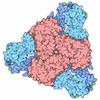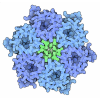[English] 日本語
 Yorodumi
Yorodumi- PDB-8yak: Cryo-EM structure and rational engineering of a novel efficient o... -
+ Open data
Open data
- Basic information
Basic information
| Entry | Database: PDB / ID: 8yak | |||||||||||||||||||||
|---|---|---|---|---|---|---|---|---|---|---|---|---|---|---|---|---|---|---|---|---|---|---|
| Title | Cryo-EM structure and rational engineering of a novel efficient ochratoxin A-detoxifying amidohydrolase | |||||||||||||||||||||
 Components Components | Imidazolonepropionase | |||||||||||||||||||||
 Keywords Keywords | HYDROLASE / amide hydrolase / Iron-binding / Ochratoxin A / ZN | |||||||||||||||||||||
| Function / homology | : / hydrolase activity, acting on carbon-nitrogen (but not peptide) bonds / Amidohydrolase family / Metal-dependent hydrolase, composite domain superfamily / Amidohydrolase-related / Metal-dependent hydrolase / Chem-97U / Imidazolonepropionase Function and homology information Function and homology information | |||||||||||||||||||||
| Biological species |  Pseudoxanthomonas wuyuanensis (bacteria) Pseudoxanthomonas wuyuanensis (bacteria) | |||||||||||||||||||||
| Method | ELECTRON MICROSCOPY / single particle reconstruction / cryo EM / Resolution: 2.37 Å | |||||||||||||||||||||
 Authors Authors | Dai, L.H. / Xu, Y.H. / Hu, Y.M. / Niu, D. / Yang, X.C. / Shen, P.P. / Li, X. / Xie, Z.Z. / Li, H. / Guo, R.-T. / Chen, C.-C. | |||||||||||||||||||||
| Funding support | 1items
| |||||||||||||||||||||
 Citation Citation |  Journal: Int J Biol Macromol / Year: 2024 Journal: Int J Biol Macromol / Year: 2024Title: Functional characterization and structural basis of an efficient ochratoxin A-degrading amidohydrolase. Authors: Yumei Hu / Longhai Dai / Yuhang Xu / Du Niu / Xuechun Yang / Zhenzhen Xie / Panpan Shen / Xian Li / Hao Li / Lilan Zhang / Jian Min / Rey-Ting Guo / Chun-Chi Chen /  Abstract: Ochratoxin A (OTA) contamination in various agro-products poses a serious threat to the global food safety and human health, leading to enormous economic losses. Enzyme-mediated OTA degradation is an ...Ochratoxin A (OTA) contamination in various agro-products poses a serious threat to the global food safety and human health, leading to enormous economic losses. Enzyme-mediated OTA degradation is an appealing strategy, and the search for more efficient enzymes is a prerequisite for achieving this goal. Here, a novel amidohydrolase, termed PwADH, was demonstrated to exhibit 7.3-fold higher activity than that of the most efficient OTA-degrading ADH3 previously reported. Cryo-electron microscopy structure analysis indicated that additional hydrogen-bond interactions among OTA and the adjacent residue H163, the more compact substrate-binding pocket, and the wider entry to the substrate-access cavity might account for the more efficient OTA-degrading activity of PwADH compared with that of ADH3. We conducted a structure-guided rational design of PwADH and obtained an upgraded variant, G88D, whose OTA-degrading activity was elevated by 1.2-fold. In addition, PwADH and the upgraded G88D were successfully expressed in the industrial yeast Pichia pastoris, and their catalytic activities were compared to those of their counterparts produced in E. coli, revealing the feasibility of producing PwADH and its variants in industrial yeast strains. These results illustrate the structural basis of a novel, efficient OTA-degrading amidohydrolase and will be beneficial for the development of high-efficiency OTA-degrading approaches. | |||||||||||||||||||||
| History |
|
- Structure visualization
Structure visualization
| Structure viewer | Molecule:  Molmil Molmil Jmol/JSmol Jmol/JSmol |
|---|
- Downloads & links
Downloads & links
- Download
Download
| PDBx/mmCIF format |  8yak.cif.gz 8yak.cif.gz | 585.3 KB | Display |  PDBx/mmCIF format PDBx/mmCIF format |
|---|---|---|---|---|
| PDB format |  pdb8yak.ent.gz pdb8yak.ent.gz | 485.4 KB | Display |  PDB format PDB format |
| PDBx/mmJSON format |  8yak.json.gz 8yak.json.gz | Tree view |  PDBx/mmJSON format PDBx/mmJSON format | |
| Others |  Other downloads Other downloads |
-Validation report
| Summary document |  8yak_validation.pdf.gz 8yak_validation.pdf.gz | 1.9 MB | Display |  wwPDB validaton report wwPDB validaton report |
|---|---|---|---|---|
| Full document |  8yak_full_validation.pdf.gz 8yak_full_validation.pdf.gz | 1.9 MB | Display | |
| Data in XML |  8yak_validation.xml.gz 8yak_validation.xml.gz | 92.4 KB | Display | |
| Data in CIF |  8yak_validation.cif.gz 8yak_validation.cif.gz | 131.7 KB | Display | |
| Arichive directory |  https://data.pdbj.org/pub/pdb/validation_reports/ya/8yak https://data.pdbj.org/pub/pdb/validation_reports/ya/8yak ftp://data.pdbj.org/pub/pdb/validation_reports/ya/8yak ftp://data.pdbj.org/pub/pdb/validation_reports/ya/8yak | HTTPS FTP |
-Related structure data
| Related structure data |  39101MC  8yagC M: map data used to model this data C: citing same article ( |
|---|---|
| Similar structure data | Similarity search - Function & homology  F&H Search F&H Search |
- Links
Links
- Assembly
Assembly
| Deposited unit | 
|
|---|---|
| 1 |
|
- Components
Components
| #1: Protein | Mass: 43475.809 Da / Num. of mol.: 8 / Mutation: G88D, D344N Source method: isolated from a genetically manipulated source Source: (gene. exp.)  Pseudoxanthomonas wuyuanensis (bacteria) Pseudoxanthomonas wuyuanensis (bacteria)Gene: SAMN06296416_10433 / Production host:  #2: Chemical | ChemComp-ZN / #3: Chemical | ChemComp-97U / ( Has ligand of interest | Y | Has protein modification | Y | |
|---|
-Experimental details
-Experiment
| Experiment | Method: ELECTRON MICROSCOPY |
|---|---|
| EM experiment | Aggregation state: PARTICLE / 3D reconstruction method: single particle reconstruction |
- Sample preparation
Sample preparation
| Component | Name: PwADH-G88D-D344N / Type: COMPLEX Details: amidohydrolase family protein [Pseudoxanthomonas wuyuanensis] Entity ID: #1 / Source: RECOMBINANT |
|---|---|
| Source (natural) | Organism:  Pseudoxanthomonas wuyuanensis (bacteria) Pseudoxanthomonas wuyuanensis (bacteria) |
| Source (recombinant) | Organism:  |
| Buffer solution | pH: 8 / Details: 20 mM Tris-HCL,pH 8.0 |
| Specimen | Conc.: 1.5 mg/ml / Embedding applied: NO / Shadowing applied: NO / Staining applied: NO / Vitrification applied: YES |
| Vitrification | Cryogen name: ETHANE |
- Electron microscopy imaging
Electron microscopy imaging
| Microscopy | Model: FEI MORGAGNI |
|---|---|
| Electron gun | Electron source:  FIELD EMISSION GUN / Accelerating voltage: 300 kV / Illumination mode: FLOOD BEAM FIELD EMISSION GUN / Accelerating voltage: 300 kV / Illumination mode: FLOOD BEAM |
| Electron lens | Mode: BRIGHT FIELD / Nominal defocus max: 2400 nm / Nominal defocus min: 1000 nm |
| Image recording | Electron dose: 52 e/Å2 / Film or detector model: GATAN K3 (6k x 4k) |
- Processing
Processing
| EM software | Name: PHENIX / Category: model refinement | ||||||||||||||||||||||||
|---|---|---|---|---|---|---|---|---|---|---|---|---|---|---|---|---|---|---|---|---|---|---|---|---|---|
| CTF correction | Type: PHASE FLIPPING AND AMPLITUDE CORRECTION | ||||||||||||||||||||||||
| 3D reconstruction | Resolution: 2.37 Å / Resolution method: FSC 0.143 CUT-OFF / Num. of particles: 118429 / Symmetry type: POINT | ||||||||||||||||||||||||
| Atomic model building | Protocol: RIGID BODY FIT / Space: REAL | ||||||||||||||||||||||||
| Refinement | Highest resolution: 2.37 Å Stereochemistry target values: REAL-SPACE (WEIGHTED MAP SUM AT ATOM CENTERS) | ||||||||||||||||||||||||
| Refine LS restraints |
|
 Movie
Movie Controller
Controller



 PDBj
PDBj





